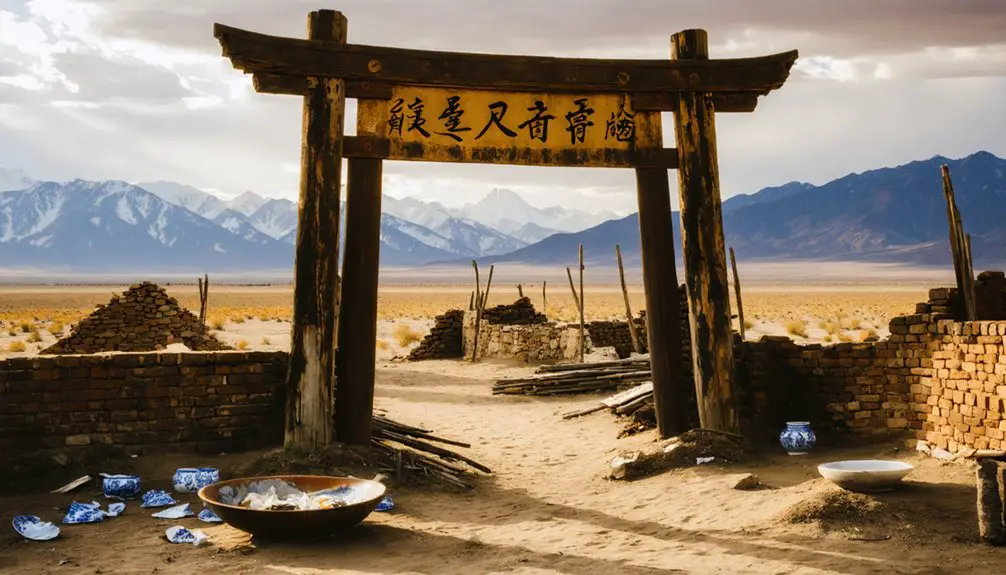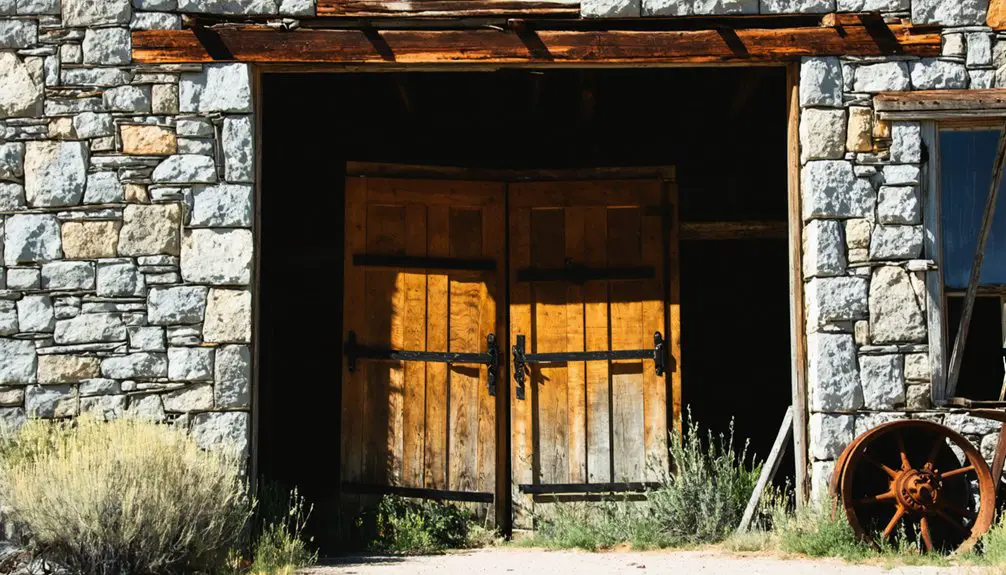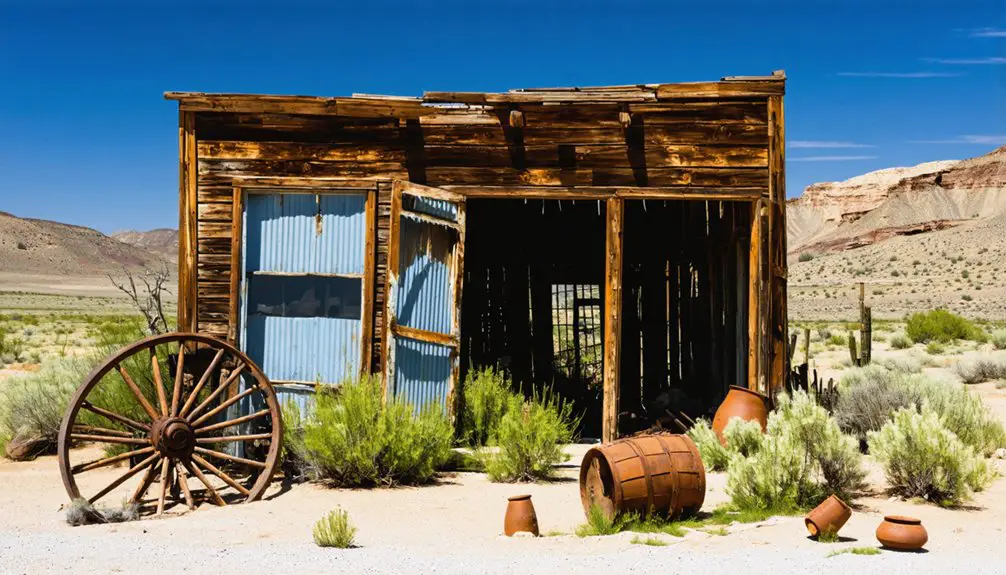You’ll find Mountain City, Nevada‘s rich mining legacy spanning three distinct booms from 1869 to the 1930s. After M.L. Henry’s initial gold discovery in 1868, the town quickly grew to 1,200 residents, complete with saloons, hotels, and a thriving Chinese community. Though now home to fewer than 100 people, you can still explore the architectural remnants of stamp mills, water systems, and the Rio Tinto company town – each structure telling a unique chapter of Nevada’s dynamic mining heritage.
Key Takeaways
- Mountain City emerged during an 1869 gold rush, reaching a peak population of 1,200 with twenty saloons, hotels, and various merchants.
- The town experienced a copper mining revival in the 1930s through Rio Tinto Copper Company, becoming Nevada’s second-largest copper producer.
- Today, Mountain City maintains a small population of under 100 residents, with preserved structures from historic silver and copper booms.
- The historic post office has operated continuously since 1870, serving as a living connection to the town’s mining heritage.
- Archaeological remnants include stamp mill foundations, water ditch systems, and Rio Tinto company town structures from multiple mining eras.
The Gold Rush That Started It All
When M.L. Henry first spotted placer gold near what would become Mountain City in 1868, he couldn’t have known he’d spark one of Nevada’s most dramatic gold rushes.
The real catalyst came in spring 1869, when Jesse Cope’s gold discovery along the Owyhee River‘s upper fork transformed this remote area into a bustling mining camp.
You’ll find it fascinating that within just months of Cope’s find, the newly-formed Cope Mining District exploded with activity.
By July 1869, the settlement had already been renamed Mountain City, and you could’ve witnessed the population surge from zero to 300 in June, then double by summer’s end.
The boom brought rapid development, including twenty saloons, multiple hotels, and even a Chinese mining settlement called Placerville, showcasing the rush’s cultural diversity.
The town’s meteoric growth continued into 1870, when the population reached over 1200 residents and more than 200 buildings dotted the landscape.
Sitting at 5,607 feet elevation, Mountain City’s high-altitude location added to the challenges miners faced during those early boom years.
Life in a Bustling Mining Town
During Mountain City’s peak in 1869-1870, you’d find yourself in a vibrant frontier community where twenty saloons, multiple hotels, and various merchants provided both necessities and entertainment for the 1,200 residents.
You could spend your evenings choosing between six restaurants or two local breweries, while during the day, the constant rhythm of stamp mills processing ore would echo through the valley as miners and merchants went about their business.
The social fabric was diverse, with a separate Chinese settlement at Placerville and two stage lines connecting the town to the outside world, though the harsh realities of frontier life and the boom-bust cycle of mining meant that such prosperity wouldn’t last. By 1932, the area saw renewed activity when the Rio Tinto Mining Company began extracting high-grade copper ore from the region. The establishment of a local school in 1871 marked an important milestone in the town’s development as a permanent settlement.
Daily Routines and Recreation
Life in Mountain City revolved around the demanding rhythm of mining operations, with workdays beginning before dawn and continuing until the last rays of sunlight disappeared behind the Nevada mountains.
You’d find miners tackling grueling daily routines, operating stamp mills that processed up to eighteen tons of ore, while support workers like blacksmiths and engineers kept the machinery running.
After your shift, you’d have plenty of recreational activities to choose from. You could join the crowds at one of twenty saloons, catch a film at the theater, or participate in sports at the athletic fields.
The town’s recreation centers served as community hubs where you’d meet fellow miners and their families. Despite the harsh working conditions, Mountain City offered diverse entertainment options that helped you escape the rigors of mining life.
Commerce and Community Spirit
At its economic peak in 1869, Mountain City bustled with an impressive array of commercial establishments serving its 700 residents. You’d find 20 saloons, 12 hotels, 6 restaurants, 4 stores, and 2 breweries lining the streets, while stage lines connected you to neighboring towns.
The commercial evolution of the town reflected the classic boom-and-bust cycle of mining communities, yet showed remarkable adaptability. The discovery of rich ore veins in the Cope District spurred rapid development and attracted more miners to the area.
The community’s resilience shone through its diverse institutions. You could read local news in the Weekly 6 Shooter or Mountain City Times, send mail through the reliable postal service, or conduct business at various ore processing mills.
Even as mining fortunes waned, the town’s spirit persisted through ranching operations, keeping the community alive well into the 20th century.
Challenges of Mining Life
While Mountain City’s commercial success painted a picture of prosperity, daily life presented stark challenges for its mining population.
The extraction of dangerous metals like chalcopyrite and galena posed serious health risks to miners working underground.
Like the Red Devil Mine operation, workers routinely faced exposure to toxic mercury vapors.
You’d face primitive living conditions in hastily constructed shacks, battling harsh winters at high elevation with limited access to water and medical care.
Mining hazards lurked constantly, from underground dangers to toxic metal exposure in the evolving operations that ranged from placer mining to industrial stamp mills.
Economic fluctuations hit hard and fast.
You might be part of a thriving community of 1,200 one year, then find yourself among just 20 residents the next as ore deposits played out.
The boom-bust cycle meant you’d likely need to pack up and move whenever the mines stopped producing, making it nearly impossible to build lasting roots in the community.
Rise and Fall of Mountain City’s Mining Empire
The discovery of placer gold by M.L. Henry in 1868 launched Mountain City’s dramatic journey through economic fluctuations.
A single gold discovery in 1868 set Mountain City on a rollercoaster ride of economic booms and busts.
When Jesse Cope found richer deposits in 1869, miners rushed to the area, bringing advanced mining techniques and transforming a simple camp into a bustling town of 700 residents.
Much like Alder Gulch’s $30 million gold rush, Mountain City’s rise and fall followed a classic boom-bust pattern:
- Initial surge (1869-1870): Population exploded to 1,200, with mills and infrastructure worth thousands.
- Peak production (1870-1871): Multiple mills operated at full capacity.
- Sharp decline (1872-1875): Population plummeted to just 77 as ore deposits waned.
- Final revival (1932-1940s): Rio Tinto copper discovery briefly rekindled mining activity.
Today, Mountain City stands as a memorial to the fleeting nature of mining wealth, having produced $25 million in minerals before fading into a quiet ranching community.
The Chinese Community at Placerville

Driven by poverty and civil unrest in southern China, immigrant workers began arriving in Placerville during the early 1850s, establishing a vibrant Chinese community that would shape the region’s development.
Many of these immigrants initially came to California to escape the devastating Taiping Rebellion back home.
Despite facing severe discrimination and economic hardship, Chinese contributions proved essential to Placerville’s growth. You’ll find evidence of their impact in the stone masonry buildings they constructed and the critical labor they provided for mining and railroad development.
While earning just a third of what other workers made, they persevered through hazardous conditions, including dangerous tunnel blasting and harsh Sierra winters.
Their cultural resilience shines through in the archaeological remnants of their distinct neighborhoods, particularly in the Bedford Avenue and Clay Street area.
Through strong communal bonds and preservation of traditional customs, they maintained their identity while adapting to frontier life.
They contributed significantly to the local economy, with thirty freight cars daily transporting Chinese goods through nearby Battle Mountain in 1877.
1930s Revival: The Rio Tinto Discovery
In late 1919, prospector Samuel Franklyn Hunt‘s discovery of trace copper ore near Mountain City sparked a revival that would transform Nevada’s mining landscape.
When Hunt partnered with Ogden G. Chase to form the Rio Tinto Copper Company in 1931, they’d lay the groundwork for Nevada’s next great mining boom.
The Rio Tinto copper discovery’s significance becomes clear when you examine its impact:
The Rio Tinto discovery reshaped Nevada’s mining landscape, proving a pivotal moment that transformed both industry and community.
- A massive 47% copper content ore find in 1932 ignited an unprecedented mining rush
- The establishment of a modern company town with electricity and amenities
- Development of a 300-ton mill, later expanded to 400 tons in 1938
- Nevada’s elevation to becoming the second-largest copper producer during this period
This revival breathed new life into Mountain City, transforming it from a declining settlement into a thriving mining community.
Remnants of Nevada’s Mining Heritage

Modern visitors exploring Mountain City’s remnants will find a landscape dotted with architectural relics spanning multiple mining eras, from weathered 1870s stone foundations to partially intact 1930s Rio Tinto structures.
You’ll discover the cultural legacy of multiple boom-bust cycles, from the early gold rush that drew 1,200 residents to the later copper mining operations that transformed the region.
The site’s industrial archaeology tells a complex story through its layered remains: foundations of the original stamp mills that processed 18 tons of ore daily, remnants of the $10,000 water ditch system, and traces of the Rio Tinto company town with its schools and theaters.
These ruins stand as evidence to Nevada’s dynamic mining heritage, reflecting both the ambitious scale of operations and the transient nature of frontier prosperity.
Exploring a Living Ghost Town Today
When you visit Mountain City today, you’ll find a small but enduring community of fewer than 100 residents who maintain the authentic character of this historic mining settlement.
You can observe the town’s mining heritage through preserved structures and operational remnants that date back to the silver and copper booms, including the historic post office that has served continuously since 1870.
While many Nevada ghost towns stand completely abandoned, Mountain City’s status as a “living ghost town” offers you a unique glimpse into both the past and present of rural mining life.
Present-Day Population Life
Today’s Mountain City presents a rare glimpse into life within a living ghost town, where roughly 15 residents maintain a foothold in this historic Nevada settlement.
The population dynamics reflect steady growth since 2020, yet the community retains its ghost town character with minimal infrastructure and services.
Your experience of daily life in Mountain City would center around these defining aspects:
- Self-reliant lifestyle with limited municipal services and utilities
- Dependence on nearby towns for basic goods and essential services
- Strong sense of privacy and isolation in a sparsely populated area
- Direct connection to the region’s historical legacy
Community interactions remain intimate by necessity, with residents likely knowing each other well while maintaining independent lives.
The town’s minimal population creates a unique social environment where privacy and interdependence coexist.
Mining Heritage Still Visible
Throughout Mountain City’s weathered landscape, physical remnants of its mining heritage stand as silent witnesses to the town’s prosperous past.
You’ll find foundations of gold mills with their 10-stamp technology, historic water ditches that once carried Owyhee River water to placer mines, and remnants of the Robbins smelter that processed complex ores in 1871.
The evolution of mining technology is visible in the preserved structures from different eras.
You can explore buildings from the 1930s copper boom, examine the remains of supply stores built from logs and adobe, and discover the historic Chinese settlement of Placerville.
The continuously operating post office, established in 1870, serves as a living connection to Mountain City’s golden age, when it boasted twenty saloons, multiple hotels, and a thriving mining economy.
Frequently Asked Questions
What Happened to Mountain City’s Native American Population During the Mining Boom?
You’ll find Native displacement was widespread as mining operations forced indigenous peoples from their lands, creating devastating cultural impact through loss of traditional territories and reduced access to resources.
How Did Extreme Weather Conditions Affect Mining Operations in Mountain City?
Like a relentless prison guard, harsh weather patterns locked down your mining efficiency. You’d battle freezing winters that froze water supplies and brutal droughts that halted operations, forcing frequent work stoppages.
Were There Any Major Mining Accidents or Disasters in Mountain City?
You’ll find Mountain City’s worst mining disaster occurred in 1936, when six miners died from toxic gas exposure. Poor mining safety and delayed disaster response with limited oxygen equipment hampered rescue efforts.
What Role Did Women Play in Mountain City’s Development?
You’ll find women’s contributions shaped key social dynamics through household management, childcare, and community building, while supporting mining operations by maintaining family stability and fostering permanent settlement development.
How Did Mountain City Residents Get Their Food and Supplies?
You’d get your food from local bakeries, breweries, and stores, while supply routes included two stagecoach lines and wagon deliveries bringing goods from larger trade centers to Mountain City’s merchants.
References
- https://www.nevadaappeal.com/news/2019/dec/24/once-the-crossroads-of-far-northeastern-nevada-mou/
- https://westernmininghistory.com/towns/nevada/mountain-city/
- https://www.nvexpeditions.com/elko/mountaincity.php
- https://nevadamagazine.com/issue/november-december-2019/11696/
- https://nvtami.com/2025/01/16/exploring-elko-county-ghost-towns/
- https://www.gbcnv.edu/howh/MountainCity.html
- https://www.mininghistoryassociation.org/ElkoNevada2021.htm
- https://www.nevadaappeal.com/news/2019/oct/09/the-wild-history-of-the-ghost-town-of-rio-tinto/
- https://www.forgottennevada.org/sites/mountaincity.html
- https://www.mindat.org/loc-41469.html



